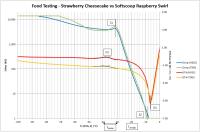 Add My Company
Add My Company
Sign In

Physicochemical Analysis of Ice Cream using Zsinϕ and DTA Techniques
Summer is here and with UK temperatures currently soaring to >30°C, our Research and Development Department is hoping to answer the question on everyone’s mind – how should I store my ice cream to prevent large ice crystals forming but still allow for an easy scoop. In order to answer this, Biopharma utilises thermal analysis techniques to determine the best storage and scooping temperatures for two separate ice cream products.
Ice creams are complex, multi-phase emulsions typically forming a post-processing product containing four phases of air, ice, fat and serum [1]. The serum component is a concentrated, unfrozen phase at the storage temperature of -20°C containing a mixture of milk solids, sweeteners, stabilisers, emulsifiers and other additives [1]. The percentage volume of each of the phases varies widely across the industry as do the concentration and nature of components comprising the serum.
The unfrozen serum forms a matrix that contains ice crystals and an immiscible, partially coalesced fat network containing air bubbles [2]. The serum phase forms the bulk of the ice cream by volume and includes a large volume of unfrozen water [2], [3]. Degradation processes resulting in a loss of stability occur predominantly in the serum phase. Breakdown of the emulsion structure is particularly important as it is inherently unstable.
Soft-serve ice creams are used directly after the freezing stage, whereas hardened versions need to be stored at -30 to -40°C to allow more water to freeze [2]. Using Zsinϕ (a derivative of electrical impedance) and differential thermal analysis (DTA) on samples of ice cream the physical reasoning can be illustrated.
For the Full article please visit our website
For more information on Summer is here, what temperature should I store my ice cream? talk to Biopharma Group
Enquire Now
More News
List your company on FindTheNeedle.

